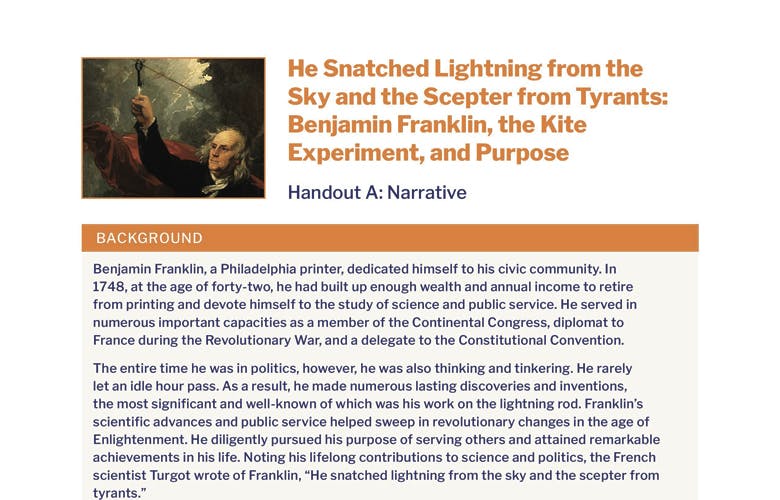He Snatched Lightning from the Sky and the Scepter from Tyrants – Handout A: Narrative
BACKGROUND
Benjamin Franklin, a Philadelphia printer, dedicated himself to his civic community. In 1748, at the age of forty-two, he had built up enough wealth and annual income to retire from printing and devote himself to the study of science and public service. He served in numerous important capacities as a member of the Continental Congress, diplomat to France during the Revolutionary War, and a delegate to the Constitutional Convention.
The entire time he was in politics, however, he was also thinking and tinkering. He rarely let an idle hour pass. As a result, he made numerous lasting discoveries and inventions, the most significant and well-known of which was his work on the lightning rod. Franklin’s scientific advances and public service helped sweep in revolutionary changes in the age of Enlightenment. He diligently pursued his purpose of serving others and attained remarkable achievements in his life. Noting his lifelong contributions to science and politics, the French scientist Turgot wrote of Franklin, “He snatched lightning from the sky and the scepter from tyrants.”
NARRATIVE
In June 1752, as the temperatures began to rise in Philadelphia, Franklin and his twentyone- year-old son, William, assembled a kite made from a silk handkerchief and two wooden crossbars. They attached the kite to several hundred feet of twine, which had a silk ribbon with a metal key tied to it. After their kite was completed, they waited for a stormy day.
During one hot afternoon that produced promising summer thunderstorms, the duo excitedly went outside. The sky darkened under a large cloud that let off rumbles of thunder. They went out to a field with a shed that they could stand under during their experiment. William helped his father get everything ready; within a few minutes, the kite was high in the air. They waited for a considerable time but were frustrated when nothing discernable happened to the kite. The thundercloud passed, and the two men feared they would need to wait until another day. The sky darkened again, however, and more thunderclouds passed overhead. Suddenly, they noticed that the stray threads on the hemp string began to stand erect. The elder Franklin knew that this signaled an electric charge. He then brought his knuckle up to the key and felt a sharp electric jolt as it sparked. The electric charge passed through the twine, causing the metal key to give off sparks. Franklin explained to his son the great significance of what they had just discovered—proof that lightning was electricity.
For Benjamin Franklin, this was not just a theoretical scientific discovery. He worked diligently to turn this knowledge into a practical lifesaving technology that would benefit humanity. Franklin announced the innovation in his Pennsylvania Gazette and Poor Richard’s Almanac, writing, “It has pleased God in his goodness to mankind at length to discover to them the means of securing their habitations and other buildings from mischief by thunder and lightning.”
Franklin devised a way to protect homes and public buildings from lightning strikes. His
innovation was to place a rod on a roof with an attached wire connected to a three-foot iron rod hammered into the ground. “A house thus furnished,” he explained, “will not be damaged by
lightning, it being attracted by the points and passing through the metal into the ground without hurting anything.”
During the summer of 1752, the world’s first lightning rods were placed atop the Pennsylvania
State House and the Philadelphia Academy. In September, Deborah Franklin was horrified to see her husband erecting such a contraption on their home. Franklin placed a nine-foothigh lightning rod on their chimney. He then set a system of wires that dropped into the main staircase where it split into two. Attached were two bells with a silk thread connecting them. On stormy nights, the bells would ring and give his wife considerable fear, especially when sparks from the bells illuminated the staircase in blue light.
Franklin was rewarded for his efforts when his own lightning rod was struck during a storm, saving his home from damage. Other homes and public buildings in Europe and America were similarly protected. Moreover, Franklin won international fame as a scientist and received the prestigious Copley Medal of the British Royal Society. Franklin did not take out patents for his invention, as he wanted to benefit mankind rather than fill his pockets with more money. He explained his reasoning for this, stating, “As we enjoy great advantages from the invention of others, we should be glad of an opportunity to serve others by any invention of ours, and this we should do freely and generously.”
Guided by his sense of purpose to improve humanity through his scientific endeavors, Franklin made other notable discoveries and inventions throughout his life. He charted the Gulf Stream for ship captains and discovered the typical path along which hurricanes traveled. In addition, he invented the Franklin Stove, which more efficiently conducted heat from chimneys and drew smoke away from indoor rooms. He also created bifocal eyeglasses which, according to Franklin, helped him “[see] distant objects as well as near ones, [and made] my eyes as useful to me as ever they were.”
Franklin dedicated his life to the noble purpose of helping humanity. His contributions to theoretical and practical science made him one of the greatest scientists of the eighteenth century. His unselfish sharing of those ideas and practical inventions for the common benefit is a model for all to follow.
